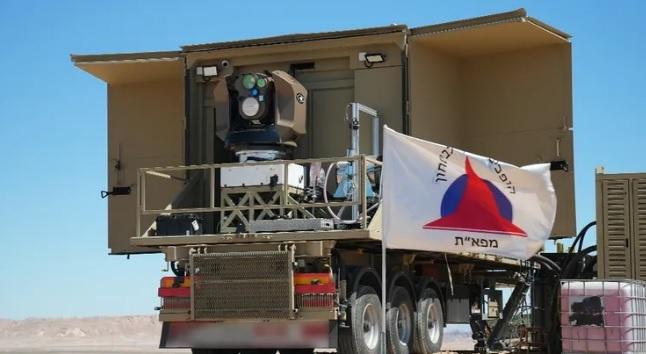According to an unconfirmed report, Israel’s Iron Beam laser system shot down a rocket fired from Gaza within recent days or weeks. If true, it would be a historic first.
The Israel Defense Forces (IDF) have yet to confirm the claim, first made on Israeli television channel 14 news on Monday.
A number of reports since the outbreak of the conflict have suggested that Israel could accelerate deployment of its Iron Beam system in advance of a notional 2024 or 2025 fielding timeframe. In 2022, Israeli Prime Minister Naftali Bennett actually said the system could be operational in 2024.
He added that it would allow Israel to surround itself “with a laser wall that will defend us from missiles, rockets, UAVs and other threats. That will essentially take away the strongest card our enemies have against us.”
Iron Beam is a directed energy weapon, specifically a high energy laser (HEL) air defense system produced by Israel’s Rafael Advanced Defense Systems. Built on two decades of research and development, the truck-mounted system reportedly uses a fiber laser with a power level of 100 kW or more.
Iron Beam rapidly acquires a target and hits it with the laser, burning rocket, missile or drone components, forcing the projectile into an uncontrolled dive. Since it is not a hit-to-kill or proximity explosive interceptor, there is less debris (shrapnel) from the targets it takes out. It is a short-range system capable of working out to around four miles to six miles (7-10 km).
The U.S. Army has been at work for an extended period on its own HEL as part of its Indirect Fire Protection Capability (IFPC) for air defense against rockets, artillery, mortars, cruise missiles and drones. Defense publication C4ISRNET noted that the Biden administration’s $106 billion emergency supplemental funding request for Ukraine and Israel includes a $1.2 billion investment in Iron Beam.
The laser portion of IFPC has been developed by Lockheed Martin
LMT
In 2022, Uzi Rubin, a senior researcher at The Jerusalem Institute for Strategy and Security and the first director of Israel’s Missile Defense Organization, told Defense News that while lasers have major cost-per-shot advantages over interceptor missiles (approximately 10 percent the cost of each missile or less), they cannot function well in fog or other poor weather. Other interference between the launcher and the target can blunt their effectiveness as well.
Iron Beam’s need to heat up targets to destroy them with its laser requires some length of time, likely in excess of one or two seconds. The system’s need to track and focus energy in that time might imply it can be defeated by multiple-projectile salvos. The same may hold true for drone swarms however drones typically fly far slower than rockets, missiles or mortars.
No per-unit price tag has been put on Iron Beam but the systems would logically be highly expensive, denting their cost-per-shot advantages until the technology matures and becomes cheaper. That would make proliferating them on the battlefield and around borders a steep investment.
However, C4ISRNET cited the fact that during Hamas’ October 7 attack on Israel it reportedly fired 3,000 to 5,000 rockets into the country over a 20-minute time period. Intercepting them via Iron Dome, David’s Sling and other anti-missile rounds has without doubt been tremendously expensive as well.
But if the reports of successful employment of Iron Beam are in fact true, the act of shooting down a Hamas rocket with a laser beam could change the strategic calculus in and around Israel and the Middle East.
Joining Iron Beam with existing integrated air and missile defense ground systems (as Israel is clearly aiming to do) could flip the cost equation for its adversaries.
Adding airborne lasers, which may become practical within a decade, to the mix could further strengthen Israel’s defenses and reorient strategic thinking about small drones as seen in Ukraine the world over. Iron Beam’s first shot in anger could be more historic than we realize.
Read the full article here





